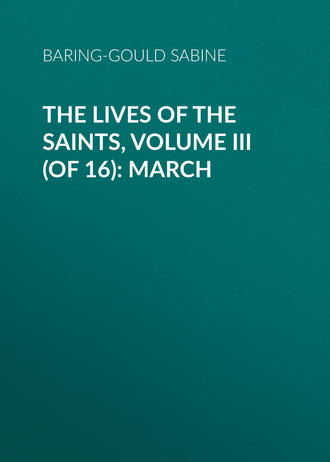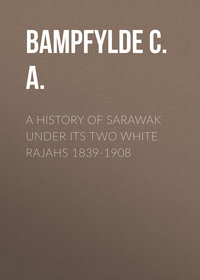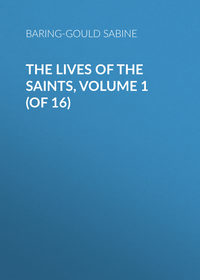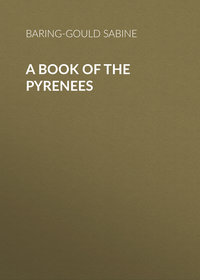 полная версия
полная версияThe Lives of the Saints, Volume III (of 16): March
Henceforth it becomes extremely difficult and next to impossible to arrange, with chronological accuracy, the subsequent transactions of S. Patrick's mission. After having celebrated Easter week, he set out on the following Monday for other places in Meath, in which he seems to have passed a considerable time. He tells us in his Confession, that to gain the goodwill of the chieftains, he used to make presents to them, and take some of their sons with him to educate them. When on the point of quitting for some time these parts of Ireland, after having established many flourishing colonies of Christians, and ordained priests to minister to them, he turned a little northward for the purpose of destroying the Crom-cruach (crooked-heap), a monument dedicated to the sun; probably a great Druidical pile of stones, superposed on uprights, standing in a plain near Feanagh, in the county of Leitrim. After this, probably in 435, he set out for Connaught, and crossing the Shannon, arrived at Dumha-graidh, where a remarkable incident occurred.
As he was advancing into the plain of Connaught, he stopped with his companions at a fountain near the royal residence Cruachan (now Croghan, near Elphin), and at break of day began to chant the praises of the Lord.
Ethnea the fair, and Fethlima the ruddy, daughters of king Leogaire, were there, and had come very early to the fountain for the purpose of washing themselves, when, looking up, they saw men clothed in white garments, holding books in their hands, advance, chanting. The damsels, full of wonder, asked them what manner of men they were, and Patrick seized the opportunity of announcing to them the true God. They asked him many strange questions, as to where God dwelt, whether he was rich, and young or old, and how he was to be revered; and Patrick explained to them the principal truths of the Christian religion in answer to their questions. Delighted with his discourse, they declared themselves ready to adopt this new and wondrous creed, so beautiful and awful, and besought the stranger to instruct them further. He did so, and on their having professed their belief in the doctrines he had propounded, he baptized them. Then they told him that they desired to see, face to face, that dear Lord who had come on earth for them on Mary's knee, and had died on Calvary top so cruel a death; so Patrick explained to them that great answer of the heart of Jesus to the heart of man, crying to see Him – the Eucharistic Presence.
"Give us the Sacrifice of the Body and Blood of Christ," they asked, "that we may be freed from the corruption of the flesh, and see our Spouse who is in heaven."
Then S. Patrick celebrated Mass, and communicated them. He proceeded west to Sligo and Roscommon, making many converts, and building several churches, to which he attached priests. In Lent, he ascended Croagh Aigle, now Croagh Padrig, in Mayo, for meditation and prayer. He preached at Firawley to an assembly of seven princes, and baptized them and 1,200 of their subjects. Passing through North Connaught, he continued his course through West Cashel, to Ulster. Thus ended his mission in Connaught, which lasted seven years. In 443, he entrusted bishop Secundinus, who, with Iserninus and Auxilius, had received consecration in Great Britain or Gaul, with the oversight of his converts in Meath and North Ireland, while he went on a mission through East Leinster and Munster.
In Leinster he baptized two princes. In Wicklow he was ill-received by prince Deichin, but was hospitably entertained by Killan, a poor man, who slew his only cow to feed Patrick and his followers. Dubtach having recommended Fiech, his pupil in bardic lore, as a fit person for ordination, Fiech received the tonsure and books for study from S. Patrick, and afterwards became chief bishop of the district, and fixed his seat at Sletty.
Entering Munster, in 445, S. Patrick went straight to Cashel; and the king came forth to meet him. His son Ængus was converted, and afterwards baptized, when he came to the throne on the death of his father. During the performance of the Sacrament, as the bishop raised his hands above the head of the king, he allowed his pastoral staff to fall unintentionally on the foot of Ængus, and the sharp point wounded him. The king made no remark, but bore the pain without flinching, supposing this act formed a portion of the ceremony.59
S. Patrick here made many converts. He spent seven years in Munster, and set out, in 432, to return to Leinster. He was followed by many chieftains, and by much people, desiring his parting blessing, and to take a last look of the dear face of him who had brought them out of darkness into the clear light of the glorious Gospel of Christ. Moved by their love, Patrick ascended a hill, and spreading forth his arms, gave his apostolic benediction to the whole of Munster. Thus was he parted from their sight in the act of blessing, like to his Divine Master, who ascended out of His disciples' sight, with his hands extended in benediction.
During his stay in Munster, Secundinus had died, the first bishop who had expired in Ireland. An alphabetical hymn, in honour of S. Patrick is, with good reason, attributed to him.
About the same time also, Cerotian, or Caradoc, a Welsh prince, made a descent on the coast, and carried off captives. This called forth from S. Patrick a letter, which is still extant. The particulars of this inroad have been elsewhere related (March 23rd, S. Fingar), and need not be repeated here.
Neither need we repeat here the escape of S. Patrick from a chieftain in Leinster who sought his death, through the generous self-sacrifice of his charioteer, Odran (Feb. 19th).
When S. Patrick reached Sabhall, his favourite retreat in Ulster, he would not take that rest he so much needed, but spent his time in completing the conversion of the natives, and building churches. But the time had come for fixing on a spot for a metropolitan see. He, therefore, went through the land, and coming into the district where is the present Armagh, a man, named Macka, offered him a site on an eminence. There he built a church and a monastery. A legend in the Book of Armagh is too good not to be true; it could hardly have been invented. According to this book, the owner of the hill was one Daeri, and Patrick having set his heart on the site, asked for it; but it was refused, and a portion of the valley offered him instead. One day the noble brought to S. Patrick a large cauldron of foreign manufacture, and presented it to him, saying, "There! this cauldron is thine." "Gratias agam (I thank thee)," answered the saint in Latin. Daeri went home muttering, "What a fool that fellow is to say only 'Gratzacham,' for a wonderful cauldron containing three firkins. Ho! slaves, go and fetch it back to me again." So the thralls went and brought back the vessel. "Well, what said he to you, churls?" "He said 'Gratzacham' again," they replied, "Gratzacham when I give, and Gratzacham when I take away! The saying is so good, that for these Gratzachams he shall have his cauldron back again. Ho! slaves, take the vessel back to Patrick." Daeri accompanied the cauldron, and praised the saint for his imperturbable self-possession; and then, in a fit of good-nature, gave him the hill which he had at first refused him. Patrick went forth to view the site, and found a roe with her fawn lying on the place where the altar of the Northern Church now is. His companions would have killed it, but the saint raised the fawn and laid it on his shoulders, and the roe trotted after him, till he laid the fawn down in another place.
He held two Synods at Armagh, at which canons for the whole of Ireland were drawn up.
S. Patrick having thus established the see of Armagh, spent the remainder of his life between it and his favourite retreat of Sabhul or Saul. He may have made excursions to some of the districts adjacent to both places; but we do not find any account that can be depended upon, of his having thenceforth visited again the other provinces of Ireland, much less of having undertaken any long journey. For we are not to listen to Jocelin, who says that he then set out for Rome with the intention of getting the privileges of the new metropolis confirmed by the Holy See; and that when he arrived there, the pope decorated him with the pallium, and appointed him his legate in Ireland. This pretended tour to Rome, and the concomitant circumstances are all set aside by the testimony of S. Patrick himself, who gives us to understand that from the commencement of his mission he constantly remained in Ireland, until he published his Confession, which was not written till after the foundation of Armagh; and that he did not leave it afterwards is equally plain, from his telling us that he was afraid to be out of Ireland even for as much time as would serve for paying a visit to his relations, because in that case he would be disobeying the orders of Christ, who had commanded him to stay among the Irish for the remainder of his life.
A singular fact is related as having occurred about the time of the building of Armagh, which shows how strictly the fasting rules were observed by the ancient Irish. One of the disciples of S. Patrick, named Colman, having been one day greatly fatigued by getting in the harvest, became exceedingly thirsty, but from fear of breaking the rule of fasting till vesper-time, would not taste a drop of water. The consequence was that he died of exhaustion. Had the saint been apprized of the danger in which Colman was, he would certainly have dispensed with his observance of the rule on this occasion.
At length we come to the last days of S. Patrick. In his extreme old age he wrote his Confession, and he seems to have felt that his dissolution was close at hand, for he concludes with these words: "And this is my confession before I die"; and provides how the work is to be carried on after his death. He had been through every province of Ireland, and he speaks of the bulk of the nation as then Christian, and of his having ordained clergy everywhere. His object in writing it was to return thanks to the Almighty for his singular mercies to himself and to the Irish people, and to confirm them in their faith, by proving that God had assisted him in a most remarkable way. He also wished that all the world, and particularly his relatives on the continent, who had so urgently opposed his going to Ireland, should know how that the Almighty had prospered his handiwork. For this reason he composed his book in Latin, apologizing, however, for the rudeness of the style; for his long sojourn in Ireland, and constant use of the Erse language, had blunted his ease in expressing himself in his native tongue.
He was at Saul when attacked with his last illness. Perceiving that his departure was at hand, he desired to go to Armagh, there to breathe his last and lay his bones. But he is said to have been arrested on his way thither by an angel, who ordered him to return to Saul. Be this as it may, to that place he went back, and there he died seven days after, on the 17th March, A.D. 465.60 In Fiech's hymn we read that his soul joined that of another Patrick, and that they proceeded together to heaven. In this singular passage the author alludes to a second Patrick, who, as he supposed, died just about the same time. Who this Patrick was we do not know.
It is curious to notice a mistake which has crept into some martyrologies, where we find a Patrick, bishop of Avernia, or Auvergne, mentioned on March 16th. But no such a Patrick is known in Auvergne; and this Patrick is simply due to a mistake of some copyist, who wrote Avernia for Hivernia or Hibernia, and so got his name into the martyrologies as a separate saint, and, to avoid confusion, this Patrick of Auvergne was placed on a different day.
There was also, or was supposed to be, a Patrick Senior, who is commemorated on August 4th. This Patrick, according to Ranulph of Chester (Polychronicron, lib. v. c. 4) was an Irish abbot, who in 850 retired to Glastonbury, and there died on the 25th of August. But that being S. Bartholomew's day there, his festival was put back to the day before. A great confusion arose, partly from this and partly from S. Patrick being spoken of in the Annals as Sen Patrick, or Senex Patrick, the old man Patrick, dying in 458.61 Now, some of the writers of the Lives were determined to give to S. Patrick a long life, equal to that of Moses, just as they made the contest of Moses and the magicians a model for a contest of Patrick and the Wise-men; so they made this
Sen Patrick into a Patrick the elder, distinct from the great apostle. And this mistake has found its way into the catalogues of the archbishops of Armagh, which has, besides S. Patrick, a namesake of his surnamed Senior. But this subject has been further obscured by the fables concerning Glastonbury, as the monks there, having a body of a Patrick of Ireland, supposed or pretended that it was the body of the great S. Patrick, and they asserted that he had come over to Glastonbury, and had died and been buried there. The Irish writers finding themselves puzzled by these Glastonbury stories, and unwilling to allow the Glastonians the honour of having among them the remains of S. Patrick, endeavoured to compromise the matter by giving them, instead of the apostle, Sen-Patrick, or Patrick Senior. This, however, was not what those monks wished for. They insisted on having the right S. Patrick, and him alone they understood by the name of Patrick Senior.
As soon as the news of the saint's death had spread throughout Ireland, the clergy flocked from all quarters to celebrate his funeral. This they did with extraordinary pomp and great profession of lights, insomuch that for a considerable time, during which the obsequies were continued, both day and night, we are told, darkness was dispelled, and the whole time seemed one continuous day. This expression of the ancient hymn of Fiech has given source to a legend that on this eventful occasion the sun went not down, but real daylight lasted for the whole function. It is said that a furious contest was very near breaking out concerning the place in which S. Patrick's remains should be deposited. To prevent bloodshed, matters were providentially so managed that his body was interred at Down. It is said to have been discovered and translated in 1185.
In art, S. Patrick is usually represented expelling serpents and other reptiles from the island with his pastoral staff, or holding a shamrock leaf. He is said to have had the golden rod of Jesus, given him by a hermit in Gaul, wherewith he smote and slew the Peishta-More, or Monster of the Lakes, and this is also frequently represented in art.
S. GERTRUDE, V. ABSS. OF NIVELLES(A.D. 664.)[Roman Martyrology, and those of Bede, Usuardus, and Ado. German, Gallican, and Belgian Martyrologies commemorate the elevation of her relics on Feb. 10th; and the translation on May 30th and April 10th. Authorities: – A Life, by an eye-witness of her acts, apparently a canon or chaplain of the monastery. He says, "I have endeavoured in writing to narrate what I have seen myself or heard from trustworthy witnesses." Another Life, written in polished style from the testimony of Rinchin, an acquaintance of S. Gertrude.]
S. Gertrude was the daughter of the B. Pepin of Landen (Feb. 21st) and S. Itta or Iduberga (May 8th). Her brother, Grimoald, succeeded her father. Her sister, S. Begga (Dec. 17th), who married duke Ansigis, and became the mother of Pepin, the father of Charles Martel. S. Aldegund (Jan. 30th), and S. Waltrudis (April 9th), the wife of S. Vincent (July 14th), were also relatives of hers.
Dagobert, king of the Franks, who had made Pepin of Landen mayor of the palace, asked him to allow him to give Gertrude in marriage to a young Frank nobleman. The father hesitated, knowing that his daughter desired to lead the religious life, and the king seeing his reluctance to force his daughter to a match for which she was not inclined, sent for Gertrude herself, then aged about ten, and endeavoured to persuade her to accept the hand offered her. But Gertrude resolutely refused, declaring that she would have no other bridegroom but Jesus Christ. The king dismissed the child, and she returned to her mother, who educated her in the love and fear of God. On the death of Pepin, in 646, Iduberga, following the advice of S. Amandus, bishop of Maestricht, built the celebrated convent of Nivelles, and retired into it with her daughter, then aged fourteen. They were soon followed by a numerous company of maidens, and a community was formed, to which the blessed Iduberga gave rules. The sisters were called canonesses, and Iduberga appointed her daughter abbess. Thus the mother obeyed the child. The holy woman spent twelve years in this peaceful retreat, and died in the odour of sanctity. After her mother's death, Gertrude made some alterations in the community. She instituted canons, who should attend to the temporal affairs of the house, whilst she devoted herself to the internal government of the sisterhood, and their spiritual training. For this latter purpose Gertrude devoted herself especially to the study of Holy Scripture, and nearly learnt the whole by heart. She also built hospitals for the reception of pilgrims, widows, and orphans, and entrusted the discipline of them to the canons and canonesses of her community.
After having spent many years in the practice of every virtue, feeling a great langour come over her, so that she was unable to discharge her duties with that activity which had been so conspicuous in her government of the house, she resigned the office of superior, and created her niece, S. Wilfetrudis, abbess in her place. Wilfetrudis was aged twenty; she had been brought up by S. Gertrude, who had made of her a mirror of perfection. Gertrude now redoubled her austerities, wore a rough horsehair shirt, and adopted an old veil which a nun who had lodged in the convent, on her way elsewhere, had left behind her, deeming it too poor to be worth preserving. Gertrude cast it over her, and bade the sisters bury her in it when she was dead. When she felt that her hour was approaching, she sent one of her canons to the monastery of Fosse, in the diocese of Liége, to ask S. Ultan, brother of SS. Fursey and Forillan, when she must die. The saint replied to the messenger, "To-morrow, during the celebration of the holy Mass, Gertrude, the spouse of Jesus Christ, will depart this life, to enjoy that which is eternal. Tell her not to fear, for S. Patrick, accompanied by blessed angels, will receive her soul into glory." And it was so, that after she had received extreme unction, and the priest was reciting the prayers before the preface in the holy Sacrifice, on the morrow, the second Sunday in Lent, she breathed forth her pure soul.
Her relics are preserved to this day at Nivelles, together with a goblet (Patera Nivigellensis), in which the custom to drink to the honour of S. Gertrude (Sinte Geerts-Minne). From the saint having established large hospices for the reception of pilgrims and travellers, whom she entertained with great liberality, arose the custom of travellers drinking a stirrup cup to her honour before starting on their journey. She became the patroness of travellers. Then, by a curious popular superstition, she was supposed to harbour souls on their way to paradise. It was said that this was a three days' journey. The first night they lodged with S. Gertrude, the second with S. Gabriel, and the third was in Paradise. She, therefore, became the patroness and protector of departed souls. Next, because popular Teutonic superstition regarded mice and rats as symbols of souls, the rat and mouse became characteristics of S. Gertrude, and she is represented in art accompanied by one of these animals. Then, by a strange transition, when the significance of the symbol was lost, she was supposed to be a protectress against rats and mice, and the water of her well in the crypt at Nivelles was distributed for the purpose of driving away these vermin. In the chapel of S. Gertrude, which anciently stood in the enclosure of the castle of Moha, near Huy, little cakes were distributed, which were supposed to banish mice. For long the right to distribute these cakes belonged to the Jesuits; after the suppression of that order, the Augustinians of Huy usurped the right, but it was resisted by the curé of Moha, who claimed the privilege as belonging to the parochial clergy. The chapel was destroyed at the French Revolution, and with it the custom disappeared.
In order to explain the significance of the mouse in pictures of S. Gertrude, when both of these meanings were abandoned, it was related that she was wont to become so absorbed in prayer that a mouse would play about her, and run up her pastoral staff, without attracting her attention.
S. WITHBURGA, V(A.D. 743.)[Some ancient martyrologies, others on July 8th. Authority: – The Ely Chronicle, and a Life supposed to be by Goscelin, the historian of S. Werburga.]
The royal race of the Uffings of East Anglia was remarkable for the crowd of saints which it produced. King Anna, who married the sister of Hilda, the celebrated abbess of Whitby, became father of three daughters and a son. The son became in his turn the father of three daughters, two of whom were in succession abbesses of Hackness in Northumbria, founded by their grand-aunt S. Hilda, and the last, Eadburga, became abbess of Repton.
The three daughters of Anna, – Etheldreda, Sexburga, and Withburga – are all counted among the saints. Withburga was sent into the country to be nursed, and remained there till she heard, while still quite young, of her father's death on the battle-field. She resolved immediately to seek a refuge for the rest of her life in claustral virginity. She chose as her asylum a modest remnant of her father's lands at East Dereham, in Norfolk, and there built a little monastery. But she was so poor that she, her companions, and the masons who built her future dwelling, had to live on dry bread alone. One day, after she had prayed long to the blessed Virgin, she saw two does come out of the neighbouring forest to drink at a stream whose pure current watered the secluded spot. Their udders were heavy with milk, and they permitted themselves to be milked by the virginal hands of Withburga's companions, returning every day to the same place, and thus furnishing a sufficient supply for the nourishment of the little community and its workmen. This lasted till the ranger of the royal domains, a savage and wicked man, who regarded with an evil eye the rising house of God, undertook to hunt down the two helpful animals. He pursued them with his dogs across the country, but, in attempting to leap a high hedge, his horse was impaled on a post, and the hunter broke his neck.
Withburga ended her life in this poor and humble solitude; but the fragrance of her gentle virtues spread far and wide. The fame of her holiness went through all the surrounding country. The veneration given to her by the people of Norfolk was maintained with the pertinacity common to the Anglo-Saxon race, and went so far that, two centuries after her death, they armed themselves to defend her relics from the monks of Ely, who came, by the king's command, to unite them to those of her sisters at Ely.
There still exists at East Dereham a well bearing the name of S. Withburga. It is fed by a spring rising in the very place where the saint's body was laid before its translation to Ely.
S. PAUL, M(ABOUT A.D. 760.)[Roman Martyrology and Greek Menology. Authority: – The Acts of S. Stephen the junior (Nov. 28th).]
In the furious persecution waged by Constantine Copronymus against images and those who reverenced them, Paul, a Cypriot, was brought before the governor of that island, Theophanes Lardotyrus, and was ordered to choose whether he would stamp on a crucifix laid before him, or suffer torture on the rack. In answer, he stooped and kissed the image of his Master, saying, "Far be it from me, Lord Jesus Christ, only begotten Son of God, to trample on Thy sacred representation." He was at once stripped, pressed between two boards, his body torn with iron combs, and then hung head downwards over a fire, which was heaped about him, till he was consumed.
March 18
S. Gabriel the Archangel.
S. Alexander, M.B. of Jerusalem, A.D. 250.
SS. Ten Thousand Martyrs, at Nicomedia, 4th cent.
SS. Trophimus and Eucarpus, MM. at Nicomedia, circ. A.D. 300.
SS. Narcissus, B.M., and Felix, D.M. at Gerona, beginning of 4th cent.









